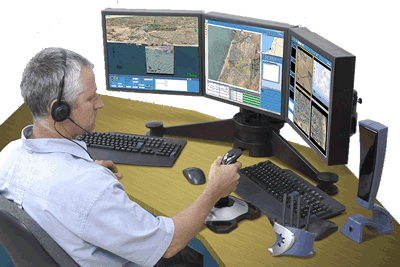IAI is introducing the Twister, net-centric command and control system. Twister is designed as a scalable system to manage multiple missions by joint forces at divisional level and higher. Twister, co-developed by IAI/MALAT, IAI/MLM and NESS TSG is designed to assist commanders and their staff in planning, execution and control of time critical complex missions, by sharing sensors, and control ad-hoc task-oriented joint forces, effectors and support elements.
The system can integrate airborne UAVs, airborne, ground or mobile observation posts, air- and ground-mobile, as well as maritime forces, to perform complex synchronized missions. Twister operators can tap into live imagery delivered from imaging and electronic sensors, as well as radar, air operations picture (AOP), as well as archived data to deliver actionable intelligence. Utilizing the same net-centric connectivity, The commander can dynamically allocate these resources to be shared by all mission participants and target specific forces and effectors.
To simplify the complex battlespace picture, Twister implements unique information visualization technologies to support intuitive situational understanding. The Twister Tactical Situation Display utilizes three flat-panel displays showing different mission views. A typical display shows a detailed 2D digital map, presenting the locations of the task force members, blue forces, and enemy. All assets associated with the mission are also presented, indicating progress of execution and critical synchronization data.
A second display focuses on sensor management, showing a large number of simultaneous real-time video streams and “thumbnails” of other available sensors which can be tasked to support the mission. Primary windows are using MPEG 2 compression while multiple thumbnails windows use MPEG 4. When the mission controller assumes control of specific sensors he can point them to look at the target of interest and designate a target of interest for the “lead sensor” which automatically slaves the other sensors to ensure continuous coverage from multiple directions. This capability enables the mission controllers to ensure the continuous coverage while leaving platform management and control tasks to the individual system operators. Interpretation of data is immediately dispatched to the relevant users with annotations, marking and text overlaid on the image or video and shared through the network.
A third display can be used to create a 3D view of the battlespace. The system has a unique capability to integrate, correlate and display real-time image or video stream depicting the sensor’s location, line of sight and footprint in real-time. This representation enables more intuitive situational understanding, to enable rapid extraction of target location required for targeting and attack.
Collaboration tools include combined mission awareness picture, graphical tools and application sharing, and instant messenger. are utilized for planning and Simulation technology based on the latest CAE simulation architecture, are inherent with Twister to supports joint mission training, planning and debriefing, to retain and develop combat experience and expertise gained by personnel and systems. By optimal utilization of sensors and efficient assignment of the various means of engagement the system dramatically cuts Sensor-to-effector cycles and distributes complete situational understanding among all mission participants, improving the readiness and rapid response during joint forces operations.
Based on state of the art Commercial Off the Shelf (COTS) technologies, industry standards, and on open, modular and robust architecture, Twister enables cost effective customization and simple integration to adapt for customer specific requirements. Advanced mission interfaces of video, voice and data are used to establish a common graphic collaborative language between joint forces.
Each of the resources managed by the system, including sensors, units and effectors is an element. Each element interfaces with Twister’s core system through a Mission Interface Gateway (MIG) which translates its properties, capabilities, performance, doctrine and rules of engagement to common language used by the Twister Core System (TCS). The system also expends the Mission Situation Picture to include environmental effects such as weather, visibility, and other dynamic parameters which could affect the performance of its elements. Twister operators and supported forces can communicate with each other and collaborate via advanced messaging, data, voice and live video embedded within the system.




















